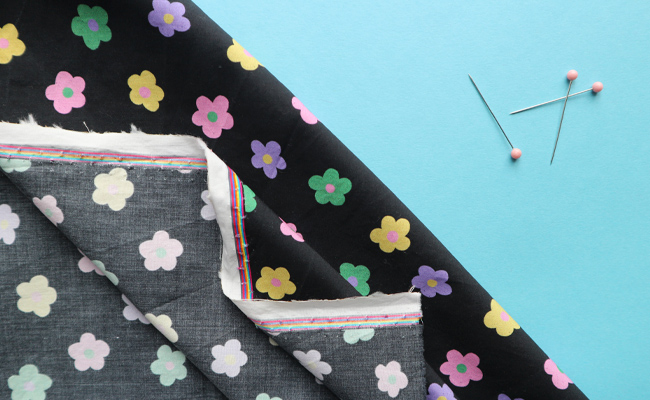
Knowing which side of your fabric is the “right side” is an essential part of any sewing project.
The “right side” of the fabric that is meant to be visible from the outside of your garment for everyone to see, while the “wrong side” is the side that will be hidden on the inside.
Sewing patterns will usually tell you to sew with right sides together, so the seams end up hidden on the inside of the garment. Exceptions include when you’re sewing French seams, in which case you start with the wrong sides together, or when you’re attaching a piece such as a patch pocket to a garment, when you’ll place the wrong side against the right side.
So it’s important to know which side is which! Some fabrics can be a lot easier to tell which is the right side than others. Others can be more tricky, but with these five simple tips, you should be able to identify yours in no time.

1) See if the right side looks different
The first and most obvious way to check which side is which is to look for any visual differences between the two sides. If your fabric has a print on only one side, then that side is most likely the right side. If your fabric has a print on both sides, the right side may appear brighter than the wrong side.
In the case of solid fabrics, you can hold the fabric up to a light source to check for any differences in tone or sheen between the two sides. Choose which one you prefer and make sure to keep your fabric the same when up when cutting your fabric to keep it consistent.

2) Check for printing on the selvedges
The selvedges are the finished edges that run lengthwise down two sides of the fabric, parallel to the grain. They are usually a different colour or texture to the rest of the fabric.
Look out for writing or markings printed on them, such as the brand name, colour chart or other info – this should be the right side.

3) Examine the selvedge more closely
Some selvedges have pinholes in them from the manufacturing process – they are usually inserted from the wrong side.
So run your finger gently across and if you feel raised dots on one side, then will probably be the right side. There can be exceptions though – some fabrics may be made the other way round, so don’t rely on this! Again, keep it consistent once you pick which side you prefer.


4) Look at the knitted structure
Knit fabrics can be particularly tricky to differentiate the right side and the wrong side, particularly if your fabric is a solid colour or the design is woven into the fabric, such as stripes that are visible on both sides.
Take a closer look at the structure – the right side often has a smoother surface with vertical ribs or little Vs; the wrong side will often have horizontal loops. Sweatshirting or French terry fabric will have soft fleece or a loop-like texture on the back, making this easier to identify.

5) Check which way the jersey rolls
For jersey fabric, again you can look for vertical ribs to ascertain the right side.
Another way to tell is to cut along the crosswise grain, at a right angle to the selvedge. When stretched, the fabric will tend to roll to the right side. The selvedges or finished edges, on the other hand, will often roll to the wrong side.
--
Still can't tell the difference?
If you still can’t tell the difference between the right side and wrong side, your fabric may be double-sided and not have one! Pick one side to be the right side – whichever you prefer – and mark the wrong side with an X or W in chalk or washable pen so you can easily see which is which when sewing – just in case the difference becomes more obvious once you step out into the daylight in your finished me-made!
